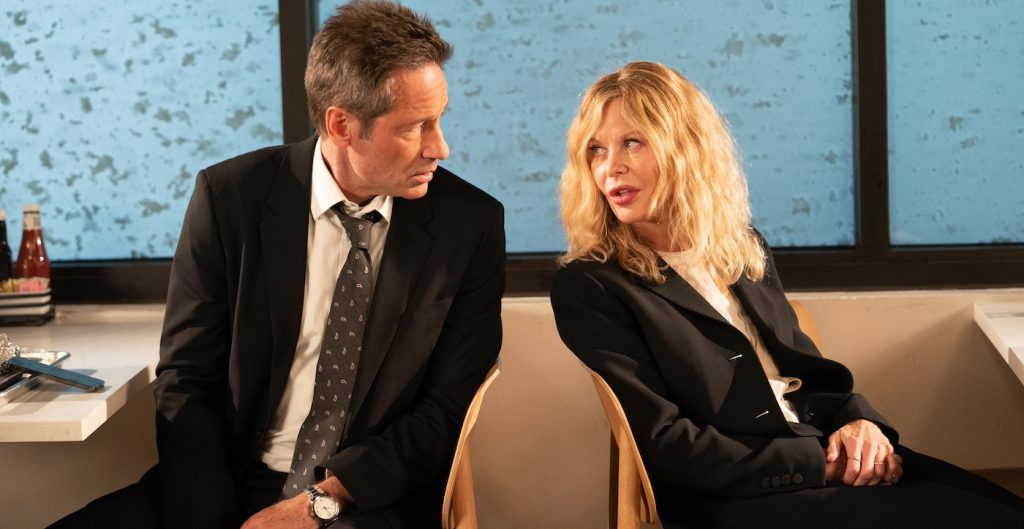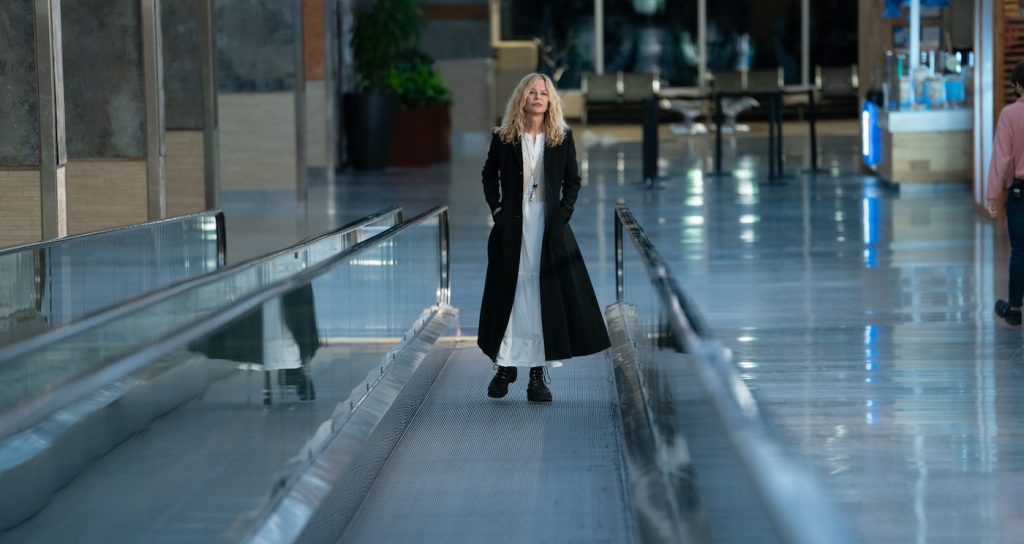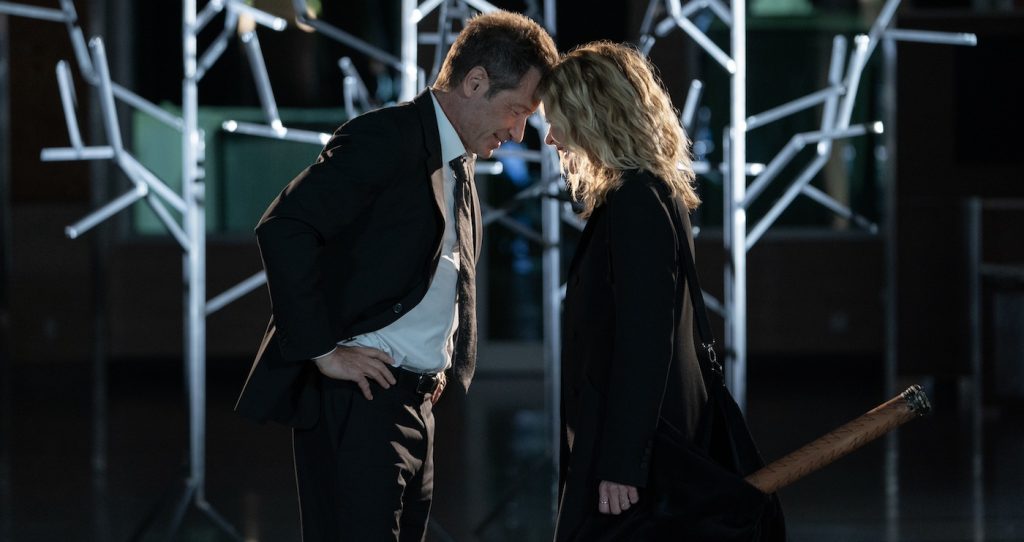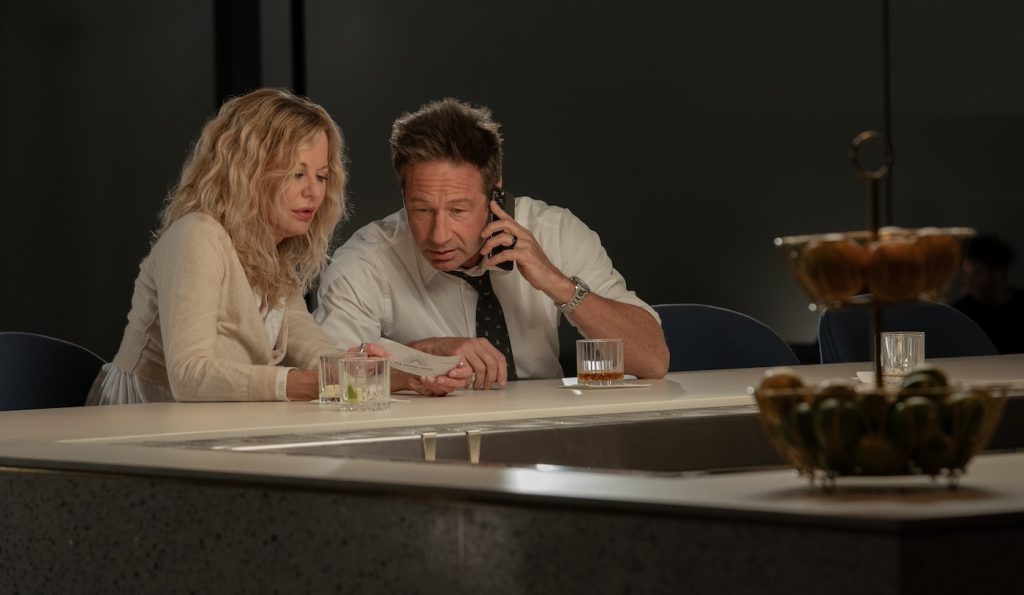Meg Ryan on Dedicating Her First Movie in Eight Years to Nora Ephron
How can Hollywood — and the world, for that matter — carry on without Meg Ryan? For someone whose fame blazed like a supernova, her absence has been felt. Ryan’s last movie was the bittersweet 2016 coming-of-age drama Ithaca, which she directed, and her last lead roles were 2008’s The Women and 2009’s little-seen comedy Serious Moonlight. Since then, she has mostly disappeared from the public eye. As Ryan tells it, she stepped away to pursue other interests, including spending time with her two kids.
Everyone loves a comeback, which brings us to What Happens Later, Ryan’s first film in eight years. Adapting a play by Steven Dietz, Ryan pulled quadruple duty: She directed, co-wrote, produced, and starred opposite David Duchovny. They play Willa and Bill, college sweethearts who reunite when they find themselves stranded in the same airport during a winter storm. With nowhere for them to go, What Happens Later is effectively one long conversation between the two exes. They catch up, rehash old history, and swap observations about weathering the passage of time. The surrounding airport carries a touch of magical realism, with loudspeaker announcements and billboards responding to Willa and Bill as they wait out their flight delays. The movie isn’t a traditional romantic comedy, but it does recall the twinkly charm that Ryan perfected in When Harry Met Sally…, Sleepless in Seattle, You’ve Got Mail, and Kate & Leopold.
Over Zoom, Ryan talked about ending her Hollywood hiatus, the surging appreciation for the once-controversial In the Cut, and how she used What Happens Later to pay tribute to the most important director of her career.
At what point did you decide to dedicate this film to Nora Ephron?
Almost the whole time, I thought about her. I am so grateful to her in general. But the idea of dedicating it to her came in the end. We had to ask the DGA to approve putting her dedication before my credit. It just felt like exactly the right thing to do. This is a piece of work that says, “I was paying attention, lady, and thank you because my life is full of blessings.” And I have to say, the DGA unanimously voted for us to be able to have that credit.
I’m sure it wasn’t a hard vote on their part. Do you feel like you evoke Nora in your directing style?
I don’t think I’ve done enough even to have a style. Serving this story was about trying to get it on its feet and not have it feel small. The directorial imperative was to make it have scope because it’s such a small and distilled story. Only two people talk. It wasn’t a big budget, so we had to pay a lot of attention to how that magical environment would be created on a shoestring. Those are big choices to make in the beginning: to shoot in a museum, to let the magic come from the reflections on the floor or the snow outside. We took away signs. We created a liminal environment. You will never see a gate number. None of that is really happening in the environment, and the ways to evoke that that we had control over were very basic, very lo-fi. It had to do with how the airport was talking to them.

The airport you create for this movie is a little bit removed from reality, but any airport is like a cocoon. It has its own rules, its own resources, and you are away from the outside world. What did that setting allow you to capture in terms of these characters and their unexpected reunion?
You’re right; it’s a natural liminal space. That was the original setting of the play, so the filmmakers took that idea and extended it as far out as we could. The airport has sentience, in a way. It was messaging them. The airport, as a larger force, has their good at heart. The airport always says yes. The airport’s imperative is that they always connect, which is an E.M. Forster quote: “Live in fragments no longer.” It’s a time machine, too. Time is very different in an airport. You’re very disoriented, and yet you’re also comforted by the unanimity of the way most airports in the world look. I remember going to an airport in Seoul, and I was seeing people get married there. The architecture of it was so beautiful. Some of these airports all over the world are actually beautiful. Of course, some regional airports in our country are not. But it’s possible to have a beautiful space there. And it’s romantic.

Everything that happens in an airport has a little bit of kismet to it.
You’re not in charge.
Given that it’s been eight years since you last made a movie, were you only interested in doing something that you were able to write and direct yourself?
No. This sort of came along. It was reactive, mostly to the pandemic. I had time to write and do this. Actually, I felt like the first movie I did; at the end, I was like, “Oh, I want to do this again because I’m starting to understand the tools that are at my disposal as a storyteller.” During the pandemic, I rented a house, and there was one book there. It was Sapiens [by Yuval Noah Harari], and it was talking about how what human beings have in common is this quirk in our brain that has to do with holding abstract ideas and holding stories — it’s essential. There was no big plan, to be honest. It was a story that came along that seemed possible to do.
What kind of scripts have you been sent over the last several years?
Some rom-coms, some stories about children because of Ithaca, some adaptations of books. But what I really learned from this is that you just have to love it. It’s three straight years. It’s a giant commitment, and I can’t imagine doing it and not loving the story. The best part is being around other artists, all operating at the top of their game.
There’s a dance sequence with David set to the Lightning Seeds song “Pure.” How did you land on that song?
The Lightning Seeds song came to us through our musical supervisor. I think it’s only been used in one movie since the ’90s, and it made us all dance in our chairs. That scene is all about them being free and the airport giving them that song after it’s been giving them all this terrible music.

All those inferior cover songs.
And I have to say a shout-out to Sheryl Crow and Alanis Morissette and Tom Petty. All those estates really trusted us with messing up their great music.
There’s a moving conversation between Willa and Bill in the airport bar where they talk about worrying that nobody wants to hear from them anymore now that they’ve aged. What struck me is whether that sentiment is autobiographical for you, especially within the context of Hollywood and the business as you’ve experienced it.
I don’t know that I think about it so much in terms of Hollywood, really. She goes, “We’re old, and we’re mute, and we’re savaged by the pharmaceutical giants.” And it’s so lame how she’s like, “I don’t accept my fate.” But it’s a little lament. He says, “Just when you get old enough to have something interesting to say, nobody wants to hear it.” I guess that just feels true. The world moves on, which it should. But you can get good at something after a long time, and then it’s no longer of use. It’s outrageous. I personally don’t feel all that sad about it. I don’t feel any kind of dead end. I hope that’s not what the movie says. It’s just a kind of lament.

When The Power of the Dog came out a couple of years ago, there was a widespread reappraisal of In the Cut. A lot of people talked about how misunderstood and underrated it was. I wonder if you noticed that and what it means to you.
Well, I’m just happy to say that Jane [Campion] is a friend of mine. She is so brave. She would say when we were making that movie that it was about grief, and a grief of hers that was particular. At that time, it was a grief of New York. New York was still shrouded in post-9/11 stuff. The buildings had black draping on them. To her, she was also grieving the idea of romance. She felt, at that time, let down by the sort of Arthurian mythology — you know, knight-in-shining-armor mythology that just doesn’t have anything to do with anything anymore. She’s a great person to have as a friend because she thinks so deeply. I was talking to Jane a little bit about this before we shot this movie. I said, “It’s going to be so beautiful because it’ll be snowing outside. We’ll have this liquid environment inside but frozen outside.” And she goes, “Meg, it’ll be beautiful because you and David will connect.” That’s the value of an artist. She’s that extraordinary. She could distill something, and it really was true: No matter how beautiful that our movie looks, and I think it does look really beautiful, the soul of it is all in the connection these two people have.
Does it mean something to you, though, to have people reacknowledging that film in particular?
If I really were aware of that, I would feel proud. I’m very proud of that movie. I just don’t read so much about it. I’m proud of working with her, of course. I love Mark [Ruffalo] in that movie. I love the darkness of that movie. That movie made me feel, maybe for the first time ever, that I was an actress. How it’s received in the world is not my affair. Even this little one: We’re just blowing up a balloon, and now it’s not ours anymore. It’s yours.
Featured image: Meg Ryan in “What Happens Later.” Courtesy Bleecker Street.



